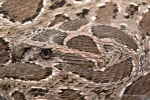Daboia siamensis
Venomous and Deadly!

|
|
|
|
|
 |
 |
 |
 |
 |
English name: Eastern Russell’s Viper (aka “Siamese Russell’s Viper”, “Chain Viper”)
Scientific name: Daboia siamensis (formerly Daboia russelii)
Thai name: Ngu Meow-sao
Description: To 166 cm long. Has a thick body and a broad triangular head. Body is yellow to brown with a row of large black-bordered blotches down the back and rows of smaller blotches down each side. Each blotch has a narrow white ring around the black border. Head is the same color as the body with several dark botches and marks that vary by region. Underbelly is white to yellowish.
Similar Species: Many-spotted Cat Snake has a slender, vertically compressed body, a smaller head, and is usually found in trees.
Mangrove Pit Viper has less distinct blotches and is only found in mangrove forests.
Burmese Python is much larger, has a larger, flatter head, and has rows of large scales along each lip.
Habitat: Most often found in open dry grassy areas. Also frequents brushy fields, scrub forest and agriculture. Can be found near human habitations, but is not commonly seen within Bangkok itself. During the day is usually found hiding in bushes, grass clumps, between rocks, or in depressions in the ground.
Place in the ecosystem: Russell’s Viper is often found near human habitations hunting mice and rats. On occasion it will also eat lizards, frogs, birds, or arthropods.
Danger to humans: Russell’s Viper is one of the deadliest snakes in Thailand. Though it may sometimes appear sluggish, when threatened it is aggressive and can strike with surprising speed. Absolutely avoid harassing this snake as it may strike without prior warning. See “Interesting Facts” for more specifics.
Conservation status and threats: A widespread collection network in southeast Asia and the killing of the snakes out of fear represent major threats to their populations.
Interesting facts: Worldwide, Russell’s Viper is one of the leading contributors to snakebite deaths. In Thailand it is one of the thee snakes most responsible for hospitalization due to snakebite and the most deadly of those three.
Russell’s Viper has a “hemorrhagic” venom which can cause difficulties in blood coagulation, intense internal bleeding, and acute tubular necrosis of the kidneys. Intense abdominal pain and vomiting may occur due to gastrointestinal bleeding. Death may come from collapse of the cardiovascular or renal systems or as a result of hemorrhaging in the brain or other organs. On average an untreated person takes approximately 48 hours to succumb to the venom, and the fatality rate without treatment may be 50%. However, Russell’s Viper-specific antivenom is widely available in Thailand and will usually save the victim’s life if administered within a few hours after the bite.
If you or someone you are with is bitten by a Russell’s Viper, the most important steps are to:
1) Keep the victim calm, having them lie down with the bite mark below the heart if possible.
2) Take a picture of the snake to confirm identification for the hospital.
3) Get the victim to a hospital immediately where professional treatment can take place and antivenom can be given.
References:
IUCN Red List: Eastern Russell’s Viper Daboia siamensis
Russell’s Viper envenoming in Hong Kong
A national hospital-based survey of snakes responsible for bites in Thailand
Reptile Database: Daboia siamensis
Wikipedia: Daboia
A Photographic Guide to Snakes and Other Reptiles of Peninsular Malaysia, Singapore and Thailand
A Field Guide to the Reptiles of South-East Asia
Snakes of Thailand and their Husbandry
Snake Bites and their Treatment
Simon and Schuster’s Guide to Reptiles and Amphibians of the World
Michael Cota, personal communication



